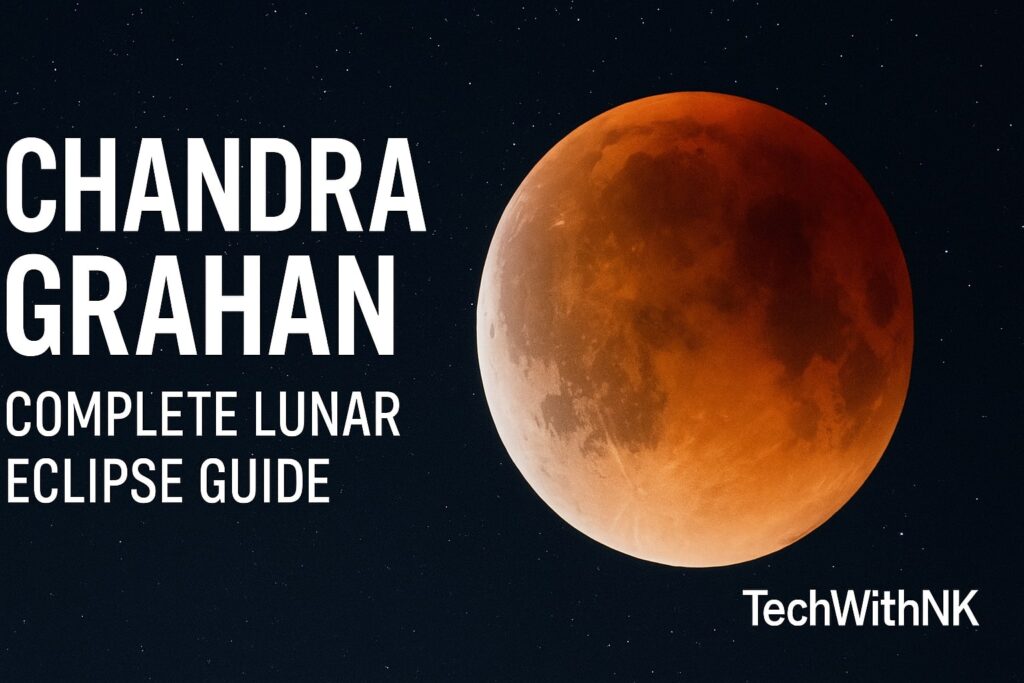Table of Contents
Toggle1. Introduction: The Mystery of Chandra Grahan
Since ancient times, the moon has been a source of fascination, inspiration, and mystery for humanity. Its soft glow lights up our night sky, controls ocean tides, and influences human culture in ways both scientific and spiritual. Among all the celestial events involving the moon, Chandra Grahan (Lunar Eclipse) stands out as one of the most awe-inspiring.
In Sanskrit, the word Chandra means “Moon,” and Grahan means “Seizure” or “Capture.” Thus, Chandra Grahan literally translates to the “capturing of the Moon.” It occurs when the Earth comes between the Sun and the Moon, casting its shadow on the Moon’s surface. This rare alignment transforms the moon’s appearance dramatically—from dimming slightly in penumbral eclipses to glowing blood-red in total eclipses.
But Chandra Grahan is more than just an astronomical phenomenon. Across cultures, it has been seen as a sign of divine power, a cosmic battle, or even a bad omen. In Indian tradition, myths of Rahu and Ketu explain eclipses as demons attempting to swallow the moon. In science, however, it is a predictable and natural event governed by orbital mechanics.
Why People Are Fascinated by Lunar Eclipses
Visibility: Unlike solar eclipses, lunar eclipses can be seen safely with the naked eye and from vast portions of the Earth.
Beauty: The sight of a Blood Moon (when the moon turns reddish during total eclipse) is breathtaking.
Cultural Beliefs: Every society has attached symbolic meanings to eclipses—from fear to celebration.
Scientific Value: Lunar eclipses help astronomers study Earth’s atmosphere and refine models of celestial motion.
In this article, we will dive deep into every aspect of Chandra Grahan—its scientific explanation, types, myths, cultural significance, historical events, astrological beliefs, and modern viewing guides.
By the end, you will not only understand what a lunar eclipse truly is but also appreciate how it connects science, spirituality, and human imagination.
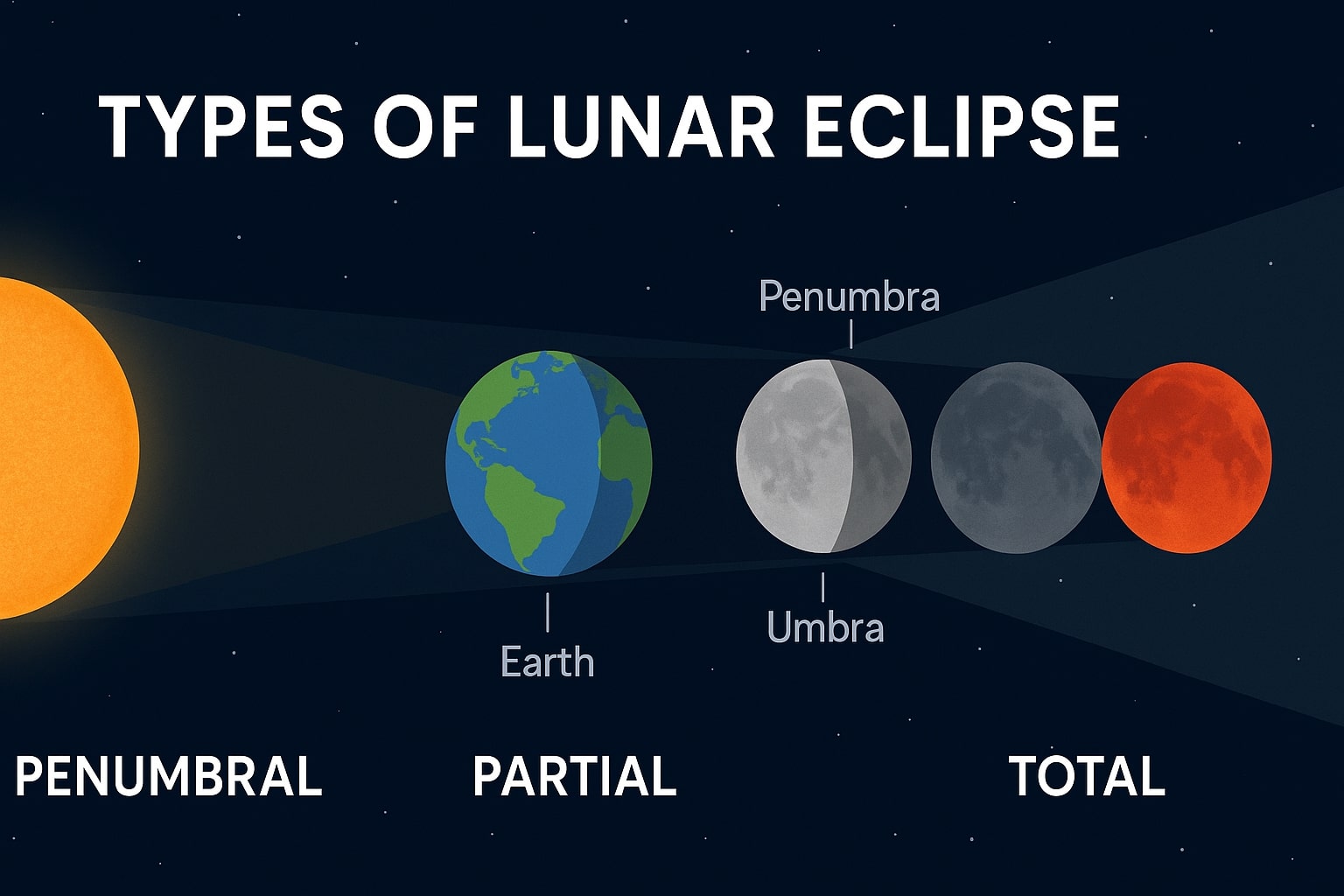
2. What is Chandra Grahan?
At its core, Chandra Grahan is a lunar eclipse, which occurs when the Earth passes directly between the Sun and the Moon, causing the Earth’s shadow to fall on the Moon.
When this happens, instead of reflecting sunlight as usual, the Moon appears darkened, coppery, or even deep red depending on the type of eclipse and atmospheric conditions.
Scientific Definition
A Chandra Grahan (Lunar Eclipse) occurs when:
The Sun, Earth, and Moon align in a straight line (or nearly straight).
The Earth blocks sunlight from reaching the Moon.
This only happens during a Full Moon phase.
Thus, lunar eclipses are cosmic alignments that require precise orbital conditions.
Types of Chandra Grahan (Lunar Eclipses)
There are three main types, each producing a different visual experience:
1. Total Lunar Eclipse (Purna Chandra Grahan)
The Moon passes completely into Earth’s umbra (darkest shadow).
It often turns red or coppery due to Earth’s atmosphere bending sunlight.
Popularly called the “Blood Moon.”
2. Partial Lunar Eclipse (Ansik Chandra Grahan)
Only a part of the Moon enters Earth’s umbra.
A portion looks darkened while the rest remains illuminated.
Less dramatic than a total eclipse but still striking.
3. Penumbral Lunar Eclipse (Upachhaya Chandra Grahan)
The Moon passes only through Earth’s penumbra (lighter shadow).
The dimming is subtle and often hard to notice with the naked eye.
Chandra Grahan vs Surya Grahan (Lunar vs Solar Eclipse)
| Feature | Chandra Grahan (Lunar Eclipse) | Surya Grahan (Solar Eclipse) |
|---|---|---|
| Occurs During | Full Moon | New Moon |
| Visibility | Seen by half the Earth (night side) | Limited path on Earth |
| Safety | Safe to watch with naked eyes | Must use eye protection |
| Frequency | About 2–4 times a year | About 2–5 times a year |
| Duration | Can last up to 3+ hours | Max 7 minutes (totality) |
Why Lunar Eclipses Don’t Happen Every Month
If the Moon orbits Earth once every 29.5 days, why don’t we see an eclipse every Full Moon?
The answer lies in the 5° tilt of the Moon’s orbit compared to Earth’s orbit around the Sun (the ecliptic). Most months, the Moon passes slightly above or below Earth’s shadow. Only when the alignment is perfect—at points called nodes—a Chandra Grahan occurs.
The Beauty of the Blood Moon
During a total lunar eclipse, the Moon doesn’t disappear completely. Instead, it glows red because Earth’s atmosphere bends sunlight, filtering out blue light and letting red/orange hues reach the Moon. This is the same reason why sunsets appear red.
So, the Blood Moon is nature’s grand performance—an indirect reflection of all Earth’s sunsets combined, cast upon the lunar surface.
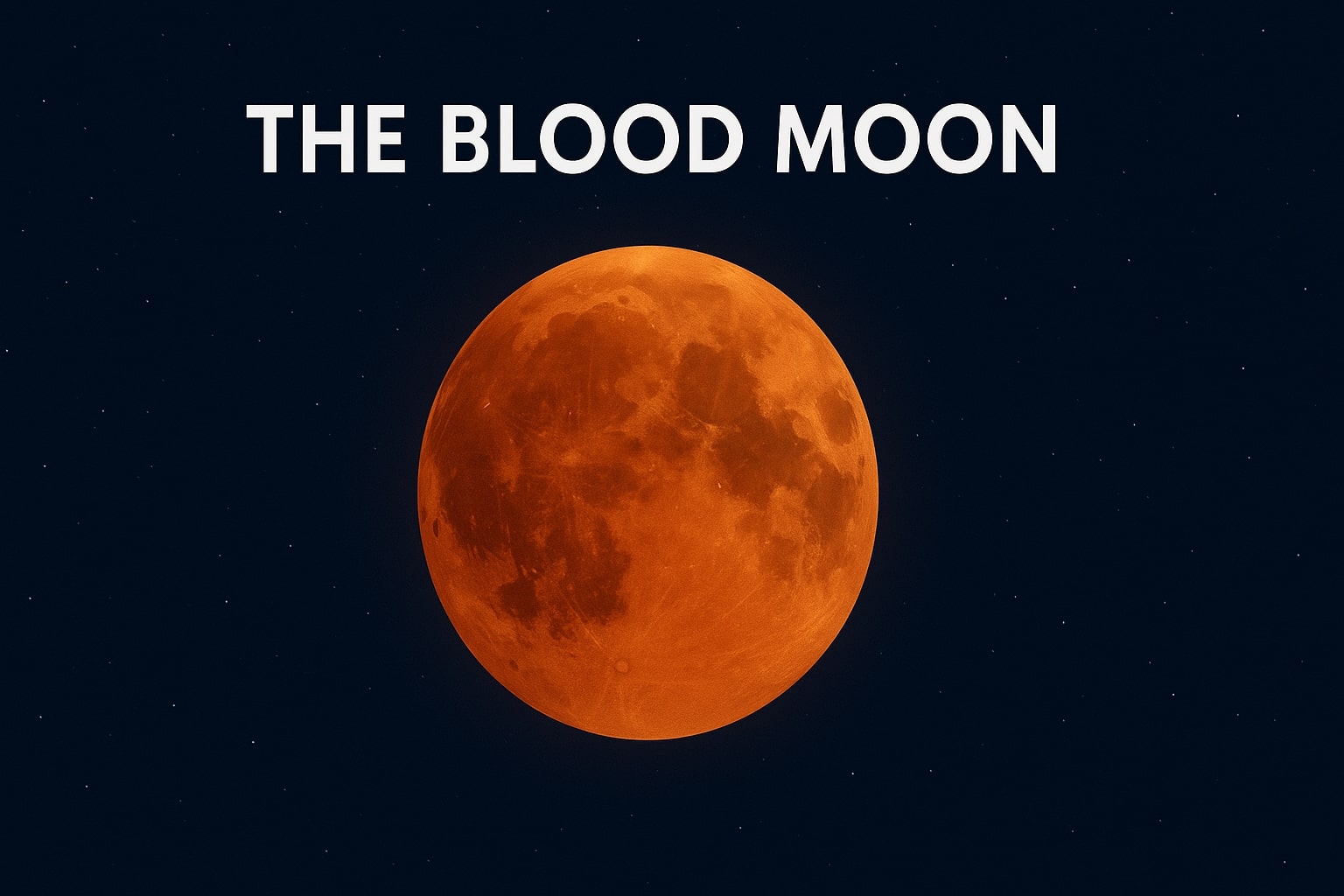
3. Astronomical Explanation of Chandra Grahan
While mythology explains Chandra Grahan through stories of demons and gods, science gives us a precise and elegant explanation rooted in orbital mechanics and celestial geometry.
🌍 The Earth–Moon–Sun Alignment
A lunar eclipse occurs only when:
The Moon is in the Full Moon phase.
The Sun, Earth, and Moon are in a nearly straight line.
The Earth’s shadow falls on the Moon.
There are two key points in the Moon’s orbit where eclipses can occur, called nodes:
Ascending Node: Where the Moon crosses from south to north of Earth’s orbital plane.
Descending Node: Where it crosses from north to south.
If a Full Moon happens near one of these nodes, Earth’s shadow covers the Moon, and we witness Chandra Grahan.
🌓 The Earth’s Shadow: Umbra and Penumbra
Earth’s shadow has two main parts:
Umbra: The central, darkest part of the shadow where Earth blocks all direct sunlight.
Penumbra: The lighter, outer shadow where Earth blocks only part of the sunlight.
When the Moon passes through:
Umbra → We get a Total or Partial Lunar Eclipse.
Penumbra → We get a Penumbral Eclipse.
This division explains why eclipses can look so different.
📏 Scale of the Eclipse
Earth is about 3.7 times larger in diameter than the Moon.
This means its shadow at the Moon’s distance is quite wide—around 9,200 km, enough to easily cover the Moon (3,476 km).
That’s why total lunar eclipses can last for hours, unlike solar eclipses which last just a few minutes.
🔴 Why the Moon Turns Red (Blood Moon)
During a total lunar eclipse, the Moon doesn’t vanish completely. Instead, it glows in shades of red or orange.
Reason:
Sunlight passes through Earth’s atmosphere.
Earth’s air scatters short-wavelength blue light but lets red/orange light pass.
This red light bends (refracts) around Earth and falls on the Moon.
This is the same reason sunsets appear red.
Thus, during a lunar eclipse, the Moon is bathed in the light of all the world’s sunsets at once.
⏱️ Duration of Chandra Grahan
Penumbral Eclipse: Up to 4 hours.
Partial Eclipse: Around 2–3 hours.
Total Eclipse: The totality (Moon fully in umbra) can last up to 1 hour 40 minutes, but the entire event can take over 6 hours.
This long duration is why Chandra Grahan is easily observed by millions.
🌌 Why Eclipses Don’t Happen Every Month
The Moon orbits Earth every 29.5 days, so shouldn’t an eclipse happen every Full Moon?
No—because the Moon’s orbit is tilted by 5° relative to Earth’s orbit around the Sun.
Most months, the Moon passes slightly above or below Earth’s shadow.
Only when a Full Moon occurs near the nodes of the orbit, we see an eclipse.
Thus, we typically get 2–4 lunar eclipses per year.
📐 Mathematical Explanation
Eclipse prediction involves celestial mechanics equations:
Saros Cycle: About 18 years, 11 days, and 8 hours. After this, nearly identical eclipses repeat.
Gamma Value (γ): Measures how centrally the Moon passes through Earth’s shadow.
γ = 0 → Central total eclipse.
|γ| > 1 → No eclipse.
For example, NASA predicts eclipses decades in advance using these models.
🛠️ Eclipse Simulation
Modern planetarium software (like Stellarium, SkySafari, or ISRO’s eclipse calculator) allows people to simulate exact times, visibility, and paths of Chandra Grahan.
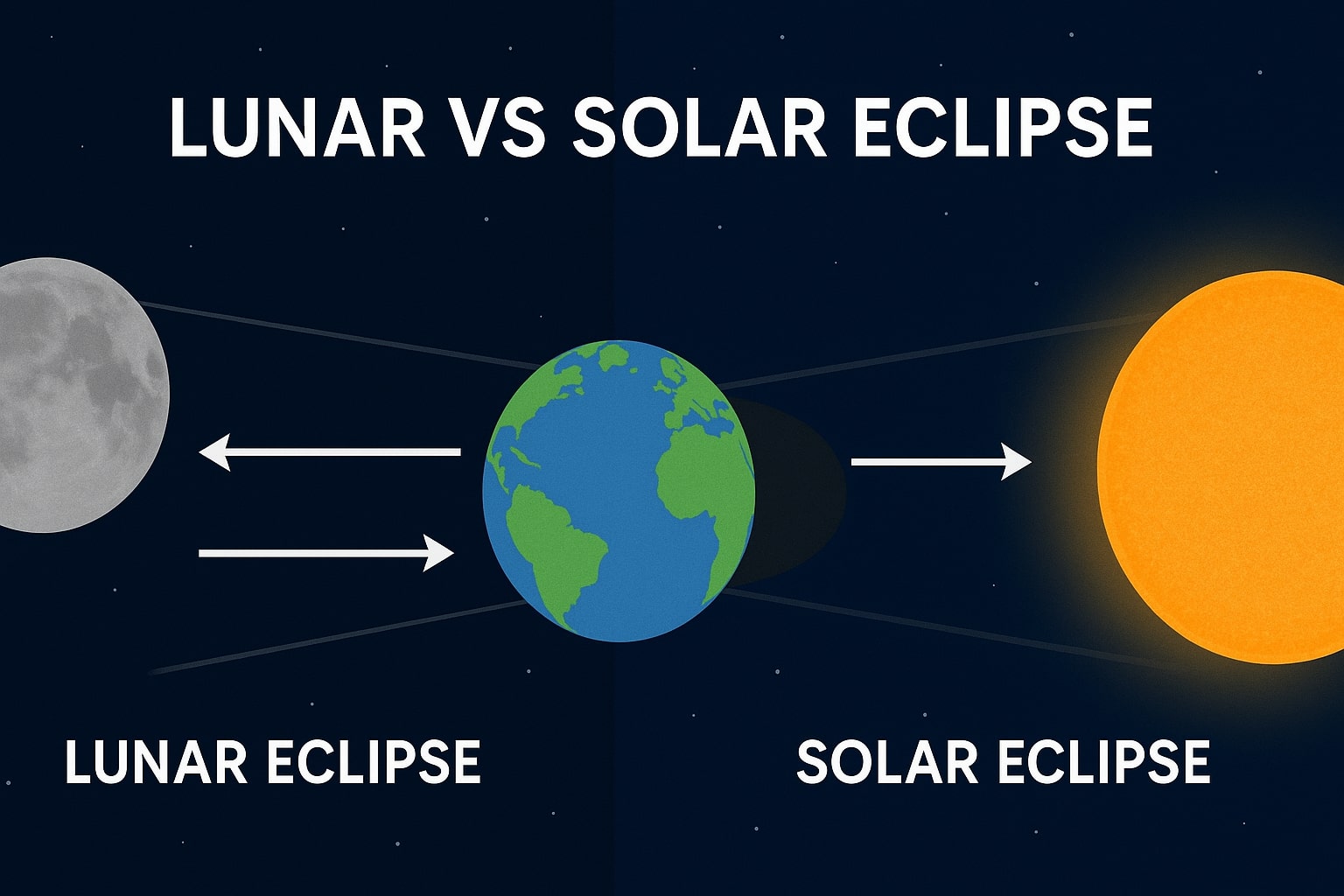
4. History of Lunar Eclipse Observations
Human fascination with Chandra Grahan is not new. For thousands of years, civilizations around the world have recorded, interpreted, and even feared eclipses.
📜 Ancient Indian Records
In Vedic literature:
The Rigveda (1500–1200 BCE) describes eclipses as battles between gods and demons.
The Surya Siddhanta (astronomical text from around 500 CE) explains eclipses scientifically as shadows of Earth—long before modern astronomy.
Indian astronomers like Aryabhata (476–550 CE) gave mathematical explanations of eclipses, challenging mythological views.
Aryabhata wrote:
“Eclipses occur due to shadows of Earth and Moon, not because of Rahu or Ketu.”
This was revolutionary in a time dominated by myth.
🇬🇷 Greek Civilization
The philosopher Aristotle (4th century BCE) observed that Earth’s shadow on the Moon during an eclipse is round.
From this, he concluded that Earth is spherical, centuries before it was widely accepted.
Greeks used eclipses to measure the size of Earth’s shadow cone and even estimate the Moon’s distance.
🇨🇳 Chinese Records
Ancient Chinese texts date back to 2100 BCE, linking eclipses with heavenly dragons eating the Moon.
People beat drums and banged pots to “scare away the dragon.”
However, Chinese astronomers also became skilled at predicting eclipses accurately by Han Dynasty (200 BCE–200 CE).
🏺 Mayan and Aztec Civilizations
Mayans believed lunar eclipses were linked with death and destruction.
In Mayan codices, a moon goddess is shown being swallowed by a serpent.
Despite mythology, Mayans created precise eclipse prediction tables (like the Dresden Codex).
🌍 Middle Eastern and Islamic World
In Mesopotamia, lunar eclipses were seen as omens for kings and nations.
The Babylonians (1000 BCE) mastered eclipse prediction using the Saros cycle.
In Islam, eclipses were occasions for special prayers (Salat al-Kusuf). Prophet Muhammad emphasized that eclipses were natural events—not linked to births or deaths.
🧭 European Medieval Era
Christopher Columbus famously used a lunar eclipse in 1504 to frighten Jamaican natives by predicting it, securing food and resources.
This showed how astronomy knowledge gave power in history.
🛰️ Modern Observations
Today, NASA, ISRO, and observatories worldwide track eclipses with millisecond accuracy.
High-resolution telescopes capture lunar eclipses in detail, studying Earth’s atmosphere.
Amateur astronomers globally livestream eclipses, making them accessible to anyone with an internet connection.
5. Chandra Grahan in Indian Mythology
India has one of the richest traditions of explaining natural phenomena through mythology, and Chandra Grahan (lunar eclipse) is no exception. Long before telescopes and space science, people tried to make sense of the mysterious darkening of the Moon through stories that blended cosmic imagination with religious symbolism.
🌑 The Rahu and Ketu Legend
One of the most famous stories comes from the Puranas.
During the churning of the ocean (Samudra Manthan), the gods (Devas) and demons (Asuras) fought over the nectar of immortality (Amrit).
Lord Vishnu, disguised as the enchantress Mohini, distributed the nectar to the gods.
However, a clever demon named Swarbhanu sneaked in and drank some nectar.
The Sun (Surya) and Moon (Chandra) noticed and informed Vishnu.
Vishnu cut off Swarbhanu’s head with his Sudarshan Chakra.
But since Swarbhanu had already tasted Amrit, he did not die.
His head became Rahu.
His body became Ketu.
Since then, Rahu and Ketu chase the Sun and Moon in revenge. When they catch them, an eclipse occurs.
Chandra Grahan = Rahu swallowing the Moon.
Surya Grahan = Rahu swallowing the Sun.
📜 References in Ancient Texts
Rigveda (c. 1500 BCE): Mentions a demon named Svarbhanu obscuring the Sun, hinting at early eclipse myths.
Mahabharata (c. 400 BCE – 400 CE): Describes lunar eclipses as battles between Rahu and celestial bodies.
Surya Siddhanta (c. 500 CE): Surprisingly, while rooted in Indian tradition, it explains eclipses scientifically as Earth’s shadow—not demons.
This duality shows how Indian culture embraced both myth and science.
🙏 Rituals and Beliefs During Chandra Grahan
Even today, many Indians observe rituals during lunar eclipses:
Fasting: People avoid eating or drinking during the eclipse, believing food becomes impure.
Pregnant Women Precautions: Expecting mothers are advised to stay indoors, avoid sharp objects, and rest to protect the baby.
Bathing Rituals: After the eclipse, people take a bath to “purify” themselves.
Mantra Chanting: Devotees chant mantras (like the Maha Mrityunjaya Mantra or Gayatri Mantra) to ward off negative energies.
Tulsi and Kusha Grass: Food items are often covered with Tulsi (holy basil) leaves, believed to absorb negative energy.
🌌 Symbolic Interpretations
In Hindu thought, Rahu and Ketu are not just demons but cosmic forces representing karmic influences.
Eclipses are reminders of the constant struggle between light and darkness, truth and illusion.
Many spiritual teachers interpret Chandra Grahan as a time for introspection, meditation, and letting go of negativity.
🎭 Chandra Grahan in Folklore
In rural India, eclipses are associated with:
Cows and Cattle: Farmers avoid letting animals graze during eclipses.
Drums and Noise: In older traditions, people would beat drums or bang vessels to “scare Rahu away.”
Astrological Remedies: Feeding the poor, charity, and chanting during eclipses are believed to reduce bad karma.
6. Chandra Grahan in Astrology
Astrology (Jyotish Shastra) plays a vital role in Indian culture, and Chandra Grahan is seen as a significant cosmic event that influences human lives. Unlike astronomy, which studies eclipses scientifically, astrology views them as energetic disturbances that impact people based on their zodiac signs (Rashi).
🌙 Astrological Meaning of Chandra Grahan
The Moon in astrology represents mind, emotions, mother, and peace of mind.
When an eclipse shadows the Moon, it is believed to disturb mental balance, emotions, and spiritual clarity.
Affected areas:
Relationships (family, mother, partner)
Mental health (stress, confusion)
Sleep patterns
Decision-making
♈ Chandra Grahan Effects on Zodiac Signs
(General beliefs in Vedic astrology – not scientifically proven)
Aries (Mesha): Restlessness, avoid major financial decisions.
Taurus (Vrishabha): Relationships tested, focus on harmony.
Gemini (Mithun): Career changes possible, avoid conflicts.
Cancer (Karka): Strong impact—Moon is ruler of Cancer. Heightened emotions.
Leo (Simha): Possible stress in leadership roles.
Virgo (Kanya): Good for spiritual progress, but avoid overthinking.
Libra (Tula): May face challenges in partnerships.
Scorpio (Vrischik): Transformation and rebirth energies.
Sagittarius (Dhanu): Caution in travel and finances.
Capricorn (Makar): Focus on career stability, avoid risks.
Aquarius (Kumbha): Time for introspection and healing.
Pisces (Meen): Increased intuition, but guard against illusions.
🕉️ Do’s and Don’ts During Chandra Grahan (Astrological Beliefs)
Do’s:
Chant mantras (Om Namah Shivaya, Maha Mrityunjaya Mantra).
Meditate and pray for inner strength.
Give charity, especially food and clothes.
Take a ritual bath after the eclipse.
Don’ts:
Avoid eating food during the eclipse.
Pregnant women are advised not to step out.
Avoid starting new ventures or signing contracts.
Refrain from cutting, stitching, or using sharp objects.
🪔 Remedies for Chandra Grahan Dosha
Astrologers often recommend remedies to reduce negative effects:
Mantra Chanting – Recite Chandra Mantra or Rahu Mantra.
Fasting – Observing a fast during the eclipse.
Charity (Daan) – Donating rice, milk, white clothes, or silver.
Temple Visit – Offering prayers to Lord Shiva or Goddess Durga.
Meditation – Using the eclipse as a time for spiritual purification.
🔭 Modern Astrological Interpretations
Many modern astrologers see Chandra Grahan not just as a negative event but as a time of transformation.
A lunar eclipse is a “cosmic reset button” that helps people release old habits.
It is believed to be ideal for ending toxic relationships, letting go of past emotions, and starting fresh.
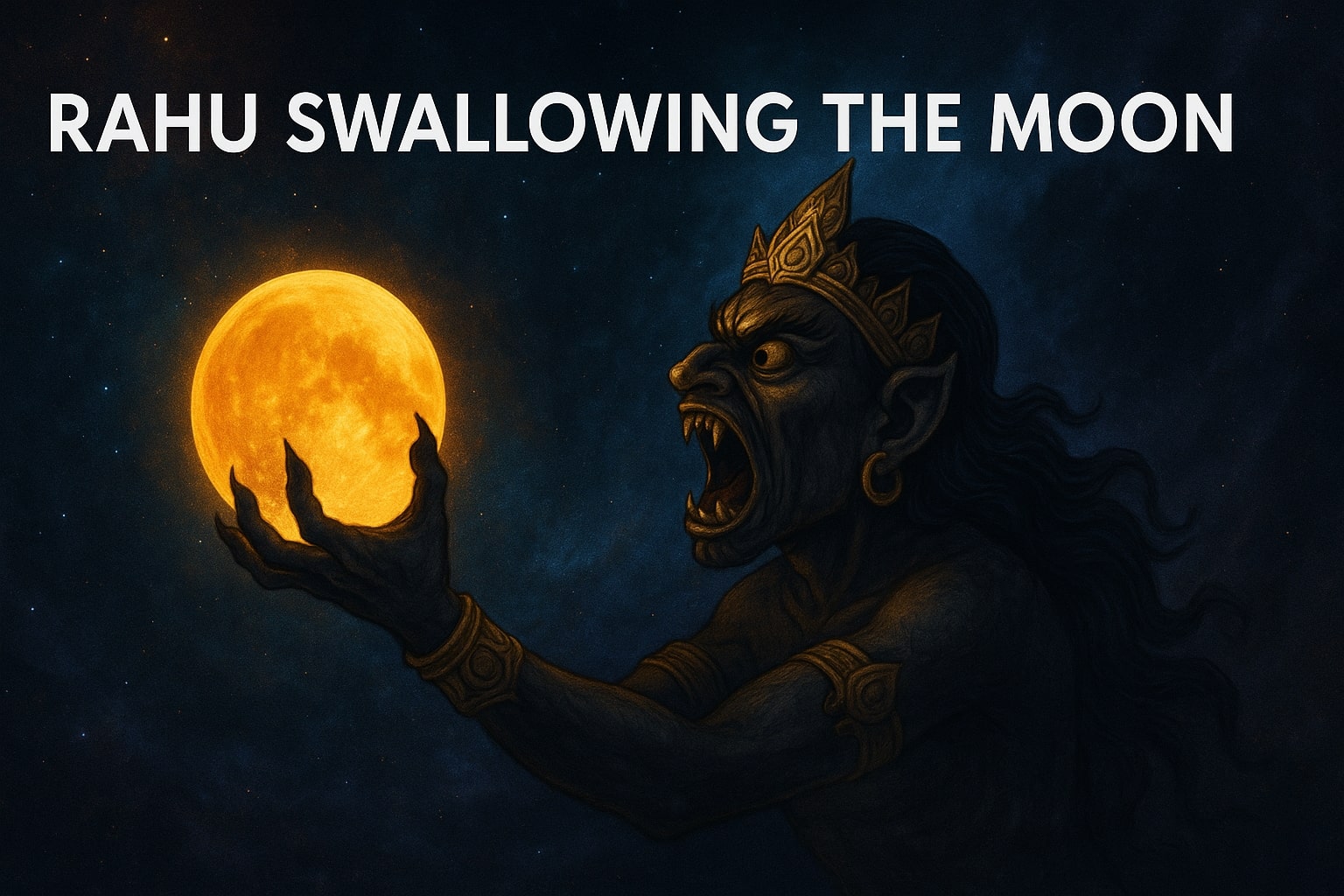
7. Cultural Beliefs Across the World
While Chandra Grahan is scientifically understood as the Earth’s shadow falling on the Moon, cultures around the world have given it deep symbolic meaning. These beliefs show how different societies viewed eclipses through the lenses of religion, folklore, and fear.
🌍 India
We already saw the Rahu–Ketu myth in Hinduism. But India’s diversity means multiple traditions exist:
North India: People chant mantras and avoid eating.
South India: Temples close during the eclipse.
Tribal Communities: Some tribes beat drums and make noise to drive away evil spirits believed to cause the eclipse.
🇨🇳 China: The Heavenly Dragon
In ancient China, eclipses were seen as dragons devouring the Moon.
People would bang pots, drums, and even fire cannons to scare the dragon away.
In Chinese astrology, eclipses symbolized cosmic imbalance and danger for emperors.
The earliest written records of eclipses in China date back to 2100 BCE.
🇯🇵 Japan: Blood and Bad Luck
In Japanese folklore, a lunar eclipse was linked to disasters and disease.
Some legends describe the Moon being stained with blood during the eclipse.
Samurai believed eclipses foretold war or famine.
🇰🇷 Korea: Sun and Moon Dogs
In Korean myths, giant dogs called Bulgae were sent by dark forces to devour the Sun and Moon.
When the dogs bit the Moon, a lunar eclipse occurred.
People prayed for the Moon’s release.
🇲🇽 Maya and Aztec Civilizations
The Maya linked lunar eclipses with death and destruction. They believed a Moon goddess was attacked by a serpent or jaguar.
Pregnant women were warned not to look at the eclipse, fearing their child would be born deformed.
The Aztecs saw lunar eclipses as omens of apocalypse.
🇦🇫 Africa
In some African tribes, eclipses were seen as a fight between the Sun and Moon.
People believed reconciliation between the two celestial bodies after an eclipse symbolized peace and renewal.
The Batammaliba people of Togo and Benin saw lunar eclipses as a time for resolving conflicts in their communities.
🇬🇷 Greece and Rome
Ancient Greeks explained lunar eclipses scientifically but still attached omens to them.
Roman generals delayed battles if an eclipse occurred, fearing divine disapproval.
🕌 Islamic Beliefs
In Islam, eclipses are natural signs of Allah’s power.
Prophet Muhammad instructed Muslims to perform a special prayer called Salat al-Kusuf during eclipses.
Importantly, Islam rejected superstitions linking eclipses with births or deaths.
✝️ Christian Traditions
In medieval Europe, eclipses were often feared as signs of the end times.
Some connected the Blood Moon with Biblical prophecies of apocalypse.
Farmers associated eclipses with poor harvests or disease.
🛕 Buddhism
In Buddhist texts, eclipses were seen as reminders of impermanence.
Monks treated them as opportunities for deep meditation and chanting.
🎭 Common Themes Across Cultures
Despite differences, many cultures share patterns:
Fear of Cosmic Monsters: Dragons, serpents, dogs, demons.
Omen of Doom: War, famine, natural disasters.
Rituals of Protection: Drums, chants, offerings, prayers.
Spiritual Opportunity: Cleansing, meditation, reconciliation.
This shows how humanity, without modern science, used imagination to explain the darkening of the Moon.
8. Scientific Importance of Lunar Eclipses
Today, we understand that Chandra Grahan is not a supernatural event but a natural alignment of celestial bodies. Yet far from being trivial, lunar eclipses play an important role in astronomy, Earth science, and even space exploration.
🔭 1. Studying Earth’s Atmosphere
During a total lunar eclipse, sunlight passes through Earth’s atmosphere before reaching the Moon.
By analyzing the color and brightness of the eclipsed Moon, scientists can study the composition of Earth’s atmosphere.
Dust, ash, or pollution in the air makes the Moon look darker and redder.
Example: After the 1991 Mount Pinatubo volcanic eruption, lunar eclipses appeared unusually dark due to ash particles.
🌍 2. Understanding Earth’s Shadow Geometry
By carefully observing eclipses, early astronomers measured:
The size of Earth’s shadow.
The distance to the Moon.
Proof that Earth is a sphere.
In fact, Aristotle (4th century BCE) cited lunar eclipses as evidence that Earth’s shadow is round.
🛰️ 3. Testing Theories of Celestial Motion
Eclipse observations helped refine models of how the Earth, Moon, and Sun move.
The Babylonians used lunar eclipses to predict future celestial events.
Modern astronomers use them to validate orbital mechanics equations.
🧪 4. Studying the Moon’s Surface
When the Moon is in Earth’s shadow, small changes in light reveal features on its surface.
Eclipses have been used to map craters and lunar topography.
They also help test the Moon’s albedo (reflectivity).
👩🚀 5. Space Research Applications
NASA and ISRO use eclipses to test instruments:
By simulating conditions of reduced sunlight, spacecraft sensors can be calibrated.
Future missions studying exoplanets use eclipse-like observations to analyze atmospheres of distant worlds.
🌡️ 6. Climate Studies
Lunar eclipses reflect global climate trends:
A brighter Moon suggests a clearer atmosphere.
A darker Moon hints at volcanic eruptions or pollution.
Thus, eclipses indirectly track Earth’s environmental changes.
📡 7. Citizen Science & Education
Eclipses are among the easiest astronomical events for the public to observe.
Amateur astronomers contribute photos, timings, and brightness data.
Educational institutions use them to spark interest in STEM fields.
🧭 8. Future Discoveries
Astronomers believe lunar eclipses could help:
Improve predictions of Earth’s climate.
Refine models of planetary atmospheres in exoplanet research.
Develop new space observation techniques.
9. Famous Historical Lunar Eclipses
Throughout history, lunar eclipses have not only inspired wonder but also influenced politics, religion, and science. Here are some of the most significant eclipses that changed the course of human events.
🏛️ 1. Aristotle’s Proof of Earth’s Shape (4th Century BCE)
The Greek philosopher Aristotle noticed that Earth’s shadow on the Moon during an eclipse was always round.
This could only happen if Earth was a sphere.
His observations provided one of the earliest scientific proofs against the flat-Earth idea.
📜 2. Thucydides and the Peloponnesian War (413 BCE)
During the Peloponnesian War, the Athenian general Nicias delayed retreating from Syracuse because of a lunar eclipse.
This hesitation led to a devastating military defeat for Athens.
Shows how fear of eclipses influenced critical political decisions.
🇨🇳 3. Chinese Eclipse Records (c. 2100 BCE onwards)
Ancient Chinese astronomers recorded lunar eclipses with astonishing accuracy.
Some court astrologers were executed if they failed to predict eclipses correctly, as they were linked to the emperor’s fate.
🛕 4. Aryabhata’s Explanation (5th Century CE, India)
Indian mathematician-astronomer Aryabhata correctly explained eclipses as the shadow of Earth, not demons.
His work challenged deep-rooted myths and established India as a center of astronomical excellence.
🌑 5. Columbus and the Jamaican Eclipse (1504)
Explorer Christopher Columbus was stranded in Jamaica.
When natives stopped supplying food, Columbus used his knowledge of an upcoming lunar eclipse to frighten them.
He told them the Moon would disappear if they didn’t obey him. When the eclipse occurred, the natives panicked and agreed to help.
This incident shows how astronomy knowledge could give power.
🇬🇧 6. Shakespeare’s Blood Moon (16th Century)
In King Lear, Shakespeare refers to eclipses as omens of chaos and disruption.
The Elizabethan audience often feared lunar eclipses as signs of plague, war, or social unrest.
🌋 7. Krakatoa Eruption and the Dark Eclipse (1883)
After the massive volcanic eruption of Krakatoa in Indonesia, ash spread worldwide.
The next few lunar eclipses appeared unusually dark and eerie, as ash particles blocked sunlight.
This demonstrated how natural disasters on Earth affect celestial events.
🚀 8. Modern Eclipses and Photography (19th–20th Century)
With the invention of cameras, scientists began documenting eclipses in detail.
Photography helped measure the brightness of the Moon and confirm theories about Earth’s atmosphere.
🌐 9. The Great Blood Moon of July 27, 2018
The longest total lunar eclipse of the 21st century (1 hour 42 minutes).
Coincided with Mars being at its closest approach to Earth, making it a spectacular night for astronomers and the public.
🌌 10. Future Eclipses and Historical Continuity
Every culture has been shaped by eclipses—sometimes through myth, sometimes through science.
Ancient civilizations used them to predict omens.
Modern astronomers use them to test space theories.
They remain bridges between past beliefs and future discoveries.
10. Chandra Grahan 2025 – Complete Guide
The year 2025 will bring exciting opportunities for skywatchers, as several lunar eclipses are expected. Let’s look at when, where, and how to watch them.
📅 Upcoming Lunar Eclipses in 2025
According to NASA & ISRO predictions:
March 14, 2025 – Total Lunar Eclipse
Visible in Asia, Europe, Africa, and Australia.
In India, this will be a prominent event, with the Moon turning red.
September 7, 2025 – Total Lunar Eclipse
Visible in most of Asia, Africa, and Europe.
India will again have excellent visibility.
Both events are total eclipses, meaning skywatchers will witness the dramatic Blood Moon effect.
⏱️ Timings in India (IST, Approx.)
March 14, 2025 – Total Lunar Eclipse
Penumbral begins: ~10:30 PM (March 13 night)
Partial begins: ~11:45 PM
Totality: ~01:15 AM – 02:30 AM
Ends: ~04:00 AM
September 7, 2025 – Total Lunar Eclipse
Penumbral begins: ~07:15 PM
Partial begins: ~08:30 PM
Totality: ~09:45 PM – 11:00 PM
Ends: ~12:30 AM (September 8)
👀 Where Can You See It?
India: Excellent visibility for both eclipses.
Worldwide:
Europe, Africa, and Asia will see both in entirety.
Americas may see partial stages depending on time zones.
🧭 How to Watch Safely
Unlike solar eclipses, lunar eclipses are completely safe to watch with the naked eye.
Best viewed under dark skies, away from city lights.
Binoculars and telescopes enhance the view.
Smartphone photography works if stabilized with a tripod.
📸 Photography Tips
Use a DSLR or mirrorless camera with telephoto lens.
Tripod is essential for long exposure.
Use manual focus to avoid blur.
Experiment with shutter speed (1/125 to 1 sec).
Capture multiple stages to create a time-lapse of the eclipse.
🌌 Cultural Significance of 2025 Eclipses in India
As always, temples may close during eclipse hours.
Ritual baths and fasting traditions will be observed.
Astrologers may give special predictions for these eclipses, especially since both are total eclipses visible in India.
📊 Astrological Impact (General Beliefs)
March 14, 2025: Occurs in Virgo-Pisces axis, said to influence emotions and decision-making.
September 7, 2025: Occurs in Aries-Libra axis, associated with relationships and partnerships.
(Note: These are traditional beliefs, not scientific facts.)
🌠 Why 2025 is Special
Having two total lunar eclipses in a year is relatively rare.
Both are visible in India, making it a golden opportunity for skywatchers, students, and photographers.
Educational institutions may organize public viewing events.
11. How to View a Chandra Grahan (Lunar Eclipse)
Unlike a solar eclipse, which requires special protective glasses, a Chandra Grahan is completely safe to watch with the naked eye. This makes it one of the most accessible astronomical events for everyone—from curious children to professional astronomers.
👀 Best Conditions to Watch
Dark Skies: Go to a location away from city lights to avoid light pollution.
Clear Weather: Clouds can obscure the eclipse; check forecasts beforehand.
High Elevation: Hilltops or terraces provide better visibility of the horizon.
Timing: Each stage of the eclipse (penumbral, partial, total) offers a unique view—plan to watch the entire event.
⏱️ Phases to Observe
Penumbral Eclipse: Subtle dimming, hard to notice.
Partial Eclipse: A “bite” appears on the Moon.
Total Eclipse (Blood Moon): The Moon glows red—most spectacular stage.
Exit Stages: Reverse sequence as the Moon leaves Earth’s shadow.
🔭 Viewing Equipment
Naked Eye: Fully safe and beautiful.
Binoculars: Enhance details of the Moon’s surface and color changes.
Telescope: Provides close-up views of craters during shadow movement.
Camera/Smartphone: Capture photos and videos (with tripod support).
📸 Photography Guide for Chandra Grahan
For Beginners (Smartphone):
Use tripod or steady surface.
Switch to Night Mode if available.
Zoom slightly but avoid digital zoom distortion.
For Enthusiasts (DSLR/Mirrorless):
Lens: 200–600mm telephoto recommended.
Aperture: f/5.6 to f/11.
Shutter Speed:
Bright phase: 1/125s.
Blood Moon: 1–2 seconds.
ISO: 200–800 (adjust as needed).
Shoot in RAW for editing flexibility.
Creative Tips:
Make a time-lapse sequence of the entire eclipse.
Capture the Moon with a landmark silhouette (temple, mountain, skyline).
Experiment with long exposures for star trails with the eclipsed Moon.
👨👩👧 Public Viewing Events
Many science centers, schools, and astronomy clubs host eclipse-watching events.
Large telescopes set up for public use.
Expert talks explaining science behind eclipses.
A great opportunity for families and students.
⚠️ Safety Notes
No special glasses are needed.
Do not confuse with solar eclipse precautions.
The only risk is eye strain from long observation—take short breaks.
12. Myths vs Science About Chandra Grahan
Eclipses have always been surrounded by myths and superstitions. While fascinating, most of these beliefs are not supported by science. Let’s examine common myths and what modern science says.
🌱 Myth 1: Food and Water Become Poisonous During Eclipse
Belief: Food cooked before an eclipse absorbs negative energy and becomes harmful.
Science: There is no physical change in food during an eclipse. Spoilage is caused by bacteria, not cosmic shadows.
Explanation: In ancient times, without refrigeration, fasting during eclipse hours may have reduced chances of eating stale food.
🤰 Myth 2: Pregnant Women Should Avoid Going Out
Belief: Eclipses harm unborn children, causing deformities.
Science: There is no radiation or harmful rays from lunar eclipses.
Explanation: The belief may have started to keep pregnant women safe at night when visibility was poor.
🔪 Myth 3: Avoid Using Sharp Objects During Eclipse
Belief: Cutting, stitching, or using knives causes accidents or curses.
Science: No evidence supports this. It’s purely cultural superstition.
Explanation: Possibly linked to the idea of staying calm and focused during a rare celestial event.
🛕 Myth 4: Temples Must Remain Closed
Belief: Divine idols absorb negative energies during eclipses, so temples close.
Science: Scientifically unnecessary, but culturally symbolic—representing purification rituals.
🌑 Myth 5: Eclipses Are Bad Omens
Belief: Lunar eclipses predict wars, deaths of kings, or natural disasters.
Science: Eclipses are predictable and have no causal connection to human events.
Explanation: Unusual sky events often triggered fear in ancient societies.
🧘 Spiritual Interpretations
Even though science rejects negative myths, many spiritual traditions treat eclipses as powerful times for meditation and self-reflection.
Symbolically, the Moon (mind) being shadowed represents inner struggles.
The re-emergence of the Moon symbolizes renewal and clarity.
🔬 Scientific Reality
Lunar eclipses are simply Earth’s shadow falling on the Moon.
They occur about 2–4 times a year, always during Full Moon.
They pose no danger to human health, food, or environment.
✅ Balancing Myth and Science
Respect cultural traditions that bring communities together.
Educate people that eclipses are natural and safe.
Use the eclipse as an opportunity for scientific outreach and cultural storytelling.
13. Astrological Remedies & Practices During Chandra Grahan
Astrology (Jyotish Shastra) has always connected eclipses with human destiny. While science views Chandra Grahan as a simple alignment of celestial bodies, astrology interprets it as a cosmic event with spiritual and karmic impact.
🕉️ Why Remedies Are Suggested
In Vedic astrology, the Moon represents mind, emotions, and stability.
When it is eclipsed, astrologers believe these qualities are disturbed.
Remedies (Upaay) are prescribed to reduce negative effects and enhance positive energy.
📿 Common Remedies During Chandra Grahan
Mantra Chanting
Recite Maha Mrityunjaya Mantra or Om Namah Shivaya for protection.
Chandra Beej Mantra (“Om Shraam Shreem Shraum Sah Chandraya Namah”) for calming the mind.
Chanting is believed to neutralize Rahu-Ketu’s effects.
Meditation and Prayer
Eclipses are seen as powerful times for meditation.
Yogis consider it ideal for mantra siddhi (empowerment of mantras).
Charity and Donations
Donating rice, milk, silver, or white clothes is recommended.
Feeding the poor or animals is considered especially beneficial.
Fasting
Many observe a strict fast during the eclipse.
Water and food are avoided until the eclipse ends.
Bathing Rituals
Taking a bath before and after the eclipse is believed to purify body and soul.
Holy rivers (like the Ganga) attract thousands during eclipses.
Protecting Food
Food prepared before the eclipse is often covered with Tulsi leaves.
Believed to prevent negative vibrations from entering.
🧘 Rituals for Pregnant Women
Astrology traditionally suggests special precautions:
Avoid looking directly at the eclipse.
Rest indoors and avoid stitching or cutting.
Chanting mantras or listening to devotional music for positivity.
(Science says these are not medically necessary, but they continue as cultural practices.)
🪔 Remedies Based on Zodiac Signs (General Beliefs)
Aries: Donate red clothes, chant Hanuman Chalisa.
Taurus: Offer milk to Lord Shiva.
Gemini: Chant Om Namo Bhagavate Vasudevaya.
Cancer: Worship Goddess Durga, offer white rice.
Leo: Light ghee lamps in temple.
Virgo: Donate green vegetables and pulses.
Libra: Offer sandalwood paste to Lord Vishnu.
Scorpio: Chant Maha Mrityunjaya Mantra.
Sagittarius: Donate yellow food items (turmeric, bananas).
Capricorn: Worship Lord Shani, feed black dogs.
Aquarius: Donate black sesame seeds.
Pisces: Offer water and flowers to Tulsi plant.
✨ Spiritual Significance
Astrologers say eclipses are opportunities for:
Letting go: Release negativity and toxic habits.
Renewal: Start fresh with new intentions.
Karma Balance: Good deeds during eclipses are believed to multiply in effect.
14. Chandra Grahan and Human Psychology
Beyond myths and astrology, many wonder: Do lunar eclipses affect the human mind and body?
🧠 The Moon and the Mind
Across cultures, the Moon is linked with emotions, sleep, and mental health.
The word “lunatic” comes from luna (Latin for Moon), reflecting this belief.
Eclipses, by altering the Moon’s light, were thought to disturb balance.
🌙 Scientific Studies
Sleep Patterns
Some studies show people sleep less and have lighter sleep during Full Moons.
Since eclipses occur on Full Moons, the same effect may happen.
Mood and Behavior
No strong evidence links eclipses to increased aggression or mental illness.
However, belief in bad omens can create placebo effects—people may feel anxious simply because they expect trouble.
Pregnancy Myths
Scientific research finds no effect of eclipses on unborn babies.
Stress from cultural fears, however, may impact mothers psychologically.
🐾 Animals and Wildlife
Animals often react strangely to eclipses.
Birds may stop singing, dogs bark restlessly, and nocturnal animals get confused.
These behaviors are due to sudden changes in light, not mystical forces.
🔬 The Placebo Effect of Belief
If someone strongly believes eclipses bring harm, they may experience anxiety, stress, or physical discomfort.
This is called the psychosomatic effect—mental fear creating real symptoms.
Education and awareness can reduce such unnecessary fear.
🌌 Positive Psychological Uses
Rather than fearing eclipses, many modern people use them as:
Moments of Reflection: A cosmic reminder of nature’s grandeur.
Mindfulness Events: Skywatching under a Blood Moon can be deeply calming.
Community Bonding: People gather with friends and family to witness the rare event together.
🧭 Balancing Science and Tradition
Science shows no harmful effects of eclipses on human health.
Psychology shows belief itself can shape experiences.
The best approach: Respect cultural traditions, but don’t live in fear.
15. Chandra Grahan and the Environment
A Chandra Grahan is not just a celestial spectacle—it also affects the natural world on Earth in subtle but fascinating ways. While no catastrophic environmental effects occur, eclipses often influence animal behavior, light patterns, and atmospheric studies.
🐦 Impact on Animals and Birds
Animals often respond instinctively to changes in light. During a lunar eclipse:
Birds: Nocturnal birds like owls may become active earlier, while day birds may prepare for rest prematurely.
Farm Animals: Cows and goats may become restless when night suddenly “darkens” further.
Pets: Dogs often bark more, sensing unusual changes.
Wildlife: Bats may come out early, mistaking the eclipse for twilight.
📌 Reason: Animals depend on natural light cues. When the Moon dims or glows red, it confuses their internal clocks.
🌊 Effect on Tides
The Moon’s gravity controls tides.
Eclipses themselves don’t directly cause stronger tides.
However, because they occur at Full Moon, when Sun–Moon–Earth are aligned (syzygy), spring tides occur—higher than normal tides.
🌡️ Atmospheric Effects
During an eclipse, Earth’s atmosphere bends sunlight, filtering red light onto the Moon. This phenomenon helps scientists:
Measure dust and pollution levels.
Detect volcanic ash or wildfire smoke effects.
Observe how climate change alters atmospheric clarity.
Example: After Mount Pinatubo’s eruption in 1991, lunar eclipses appeared much darker due to aerosols in the stratosphere.
🌱 Environmental Beliefs in Tradition
In Indian rural communities, farmers avoided sowing seeds during eclipses, fearing poor harvests.
Some believed river water during an eclipse turned impure—hence ritual baths after the event.
In African tribes, eclipses symbolized nature “resetting” and encouraged reconciliation with the environment.
🔬 Scientific Consensus
Modern science confirms:
Lunar eclipses have no harmful environmental effects.
They are safe natural events.
Their main environmental significance lies in data collection for climate studies.
16. Future of Lunar Eclipse Studies
While eclipses have been studied for millennia, their importance continues to grow in modern science, technology, and even space exploration.
🚀 1. Role in Space Missions
Testing Instruments: Space agencies (NASA, ISRO, ESA) use eclipses to test sensors under reduced light conditions.
Exoplanet Research: By studying how Earth’s atmosphere affects light during a lunar eclipse, scientists develop methods to analyze atmospheres of distant planets.
🌐 2. AI and Predictive Models
Artificial intelligence now predicts eclipses with microsecond accuracy.
Advanced models simulate visibility maps, cloud cover, and even public engagement levels.
🛰️ 3. Satellite Observations
Satellites monitor how Earth’s shadow behaves, refining knowledge of orbital mechanics.
Climate satellites track aerosols and greenhouse gases using eclipse data.
🔭 4. Amateur Astronomy’s Growing Role
With modern smartphones and telescopes, amateur astronomers record high-quality eclipse data.
Citizen science projects allow people worldwide to contribute to NASA’s databases.
🧬 5. Lunar Exploration Benefits
Eclipses help study the thermal response of lunar soil.
By observing temperature changes as the Moon enters/exits shadow, scientists learn about regolith properties—useful for future Moon colonies.
🌌 6. Cultural and Educational Outreach
Eclipses are global events uniting millions in wonder.
Future education will increasingly use them for STEM learning and cultural exchange.
🔮 7. Long-Term Predictions
Astronomers can predict eclipses thousands of years into the future using cycles like the Saros Cycle.
In the year 5000 CE, people will still be watching lunar eclipses with the same awe.
✨ The Bigger Picture
From myths of Rahu swallowing the Moon to AI-driven predictions, eclipses reflect humanity’s journey from fear to understanding.
Future generations will study Chandra Grahan not only as a celestial wonder but also as a tool for planetary science and interstellar exploration.
17. Chandra Grahan in Literature & Arts
For millennia, the Moon has inspired poets, writers, painters, and musicians. When the Moon turns red during Chandra Grahan, it becomes even more symbolic—representing mystery, danger, romance, or transformation.
📖 In Ancient Indian Literature
Rigveda: Mentions demons obscuring the Sun and Moon.
Mahabharata: Describes eclipses as omens before great wars.
Kalidasa’s Works: In plays like Raghuvamsa, lunar eclipses symbolize cosmic disturbance.
🏺 Greek & Roman Literature
Homer’s Iliad: Eclipses are linked with divine anger.
Ovid’s Metamorphoses: Describes celestial darkness as a metaphor for human tragedy.
✝️ Biblical References
The “Blood Moon” is often mentioned as a sign of the end times.
In the Book of Joel: “The Sun shall be turned into darkness, and the Moon into blood, before the great and terrible day of the Lord comes.”
🎭 Shakespeare and the Elizabethans
Shakespeare often used eclipses as metaphors for chaos and misfortune.
In King Lear, eclipses symbolize betrayal and family strife.
In Othello, eclipses hint at cosmic imbalance.
Elizabethan audiences believed eclipses foreshadowed political upheaval.
🎨 Paintings and Art
Medieval European art depicted eclipses as monsters swallowing the Moon.
Indian miniatures show Rahu and Ketu devouring celestial bodies.
Modern art often portrays lunar eclipses as romantic or apocalyptic.
📚 Modern Literature
J.R.R. Tolkien used lunar eclipses to set dark moods in The Lord of the Rings.
Contemporary Poets describe Blood Moons as symbols of love, danger, and renewal.
Sci-fi authors imagine eclipses as alien or cosmic portals.
🎼 Music and Performing Arts
Folk songs in India warn children not to eat during eclipses.
Western music often uses “Blood Moon” as a metaphor in love songs.
Dance dramas in Asia re-enact mythical battles of Rahu swallowing the Moon.
🌌 Symbolism in Literature & Arts
Red Moon = Danger, War, or Change.
Disappearing Moon = Loss, Death, or Mystery.
Reappearing Moon = Hope, Renewal.
Thus, Chandra Grahan is not only a scientific phenomenon but also a timeless artistic symbol of human imagination.
18. Chandra Grahan in the Technology Age
In the 21st century, technology has transformed how we experience and understand eclipses. What was once a source of fear is now a global event livestreamed on smartphones.
📡 1. Live Streaming & Social Media
NASA, ISRO, and astronomy channels stream eclipses live on YouTube.
Millions share eclipse photos instantly on Instagram, Twitter, and Facebook.
Hashtags like #LunarEclipse and #ChandraGrahan trend globally.
📱 2. Eclipse Tracking Apps
Smartphone apps allow anyone to track upcoming eclipses:
SkySafari, Stellarium, Star Walk: Show real-time positions.
TimeandDate App: Provides exact timings for any location.
ISRO Eclipse Calculator: Helps Indian users know visibility details.
🔭 3. Amateur Astronomy Growth
Affordable telescopes and DSLR cameras make eclipse viewing popular.
Citizen scientists contribute eclipse photos to research databases.
Online forums (Reddit, CloudyNights) discuss photography tips and predictions.
🛰️ 4. Satellites & Space Observations
Satellites record lunar eclipses to analyze Earth’s atmosphere.
ISRO’s Chandrayaan missions use eclipses to study the Moon’s thermal response.
NASA’s Hubble Telescope even observed eclipses of distant planets, using Earth’s eclipse as a model.
🌐 5. Artificial Intelligence & Data
AI algorithms predict eclipse paths with microsecond accuracy.
Image recognition software enhances amateur eclipse photos.
Machine learning helps analyze light curves to study atmosphere effects.
🎮 6. Virtual Reality & Simulations
VR apps let users experience eclipses even if skies are cloudy.
Educational platforms simulate historical eclipses (e.g., Nicias’ war delay, Columbus’ trick).
Students can “stand” on the Moon in VR to watch Earth cause the eclipse.
🎥 7. Eclipses in Movies and Media
Hollywood often uses Blood Moons in horror or fantasy films.
Indian movies sometimes use eclipses for dramatic wedding or battle scenes.
Documentaries (National Geographic, Discovery) broadcast detailed eclipse explanations.
📊 8. Public Engagement in Science
Eclipses bring millions to science fairs and observatories.
In India, planetariums host all-night viewing sessions.
Social media influencers create viral content around eclipses.
🌠 9. Future Tech Possibilities
AI-driven telescopes may livestream eclipses in 4K clarity to global audiences.
Space tourism companies may offer eclipse-viewing trips from the Moon in future.
Blockchain timestamping of eclipse photos is being explored for authenticity.
🔭 General FAQs
Q1. What is Chandra Grahan?
A lunar eclipse, when Earth’s shadow falls on the Moon.
Q2. How often does Chandra Grahan occur?
2–4 times every year worldwide.
Q3. Why does the Moon turn red during an eclipse?
Due to Earth’s atmosphere bending red sunlight onto the Moon—known as the Blood Moon.
Q4. Can we see Chandra Grahan with naked eyes?
Yes, completely safe unlike solar eclipses.
Q5. Can everyone on Earth see it?
Only people on the night side of Earth during the eclipse.
📅 Timing & Prediction
Q6. When is the next Chandra Grahan in India?
March 14, 2025 (Total Eclipse)
September 7, 2025 (Total Eclipse)
Q7. How long does an eclipse last?
Up to 6 hours (including penumbral, partial, and total phases).
Q8. Why don’t eclipses happen every Full Moon?
Because the Moon’s orbit is tilted 5° compared to Earth’s orbit.
Q9. What is the Saros Cycle?
An 18-year cycle after which nearly identical eclipses repeat.
Q10. Who predicts eclipses?
Astronomical organizations like NASA, ISRO, ESA.
🧪 Science & Astronomy
Q11. Is Chandra Grahan dangerous?
No—completely harmless.
Q12. Does it affect tides?
Eclipses occur during Full Moon, so higher tides (spring tides) happen, but eclipse itself doesn’t increase tides.
Q13. Can astronauts on the Moon see an eclipse?
Yes—they would see a solar eclipse caused by Earth blocking the Sun.
Q14. Can lunar eclipses be seen from space?
Yes, satellites observe them to study Earth’s atmosphere.
Q15. What is a penumbral eclipse?
When the Moon passes through Earth’s faint outer shadow—subtle dimming.
🛕 Myths & Beliefs
Q16. Is food poisonous during Chandra Grahan?
No—science confirms food remains unchanged.
Q17. Why do temples close during eclipses?
Cultural belief: idols absorb negative energy.
Q18. Do pregnant women face risks during eclipse?
No scientific evidence, but traditions advise precautions.
Q19. Why do people bathe after eclipse?
As a symbolic purification ritual.
Q20. Why is Tulsi leaf kept on food?
Traditionally believed to protect food from negativity.
20. Conclusion: The Eternal Magic of Chandra Grahan
Chandra Grahan is one of nature’s most breathtaking spectacles. From ancient myths of Rahu devouring the Moon to modern scientists using satellites to study Earth’s atmosphere, lunar eclipses have always fascinated humanity.
Science explains them as alignments of Earth, Sun, and Moon.
Astrology interprets them as cosmic influences on human life.
Culture celebrates them with rituals, prayers, and storytelling.
Art and literature use them as metaphors for change, danger, and rebirth.
Technology today allows us to livestream, photograph, and study eclipses like never before.
The beauty of Chandra Grahan lies in its ability to unite people—whether as scientists, believers, artists, or stargazers. It is a reminder that while we live on a small planet, we are part of a vast cosmic dance.
Next time you see the Moon slowly dim, then glow red under Earth’s shadow, take a moment to reflect:
On the science that explains it.
On the myths that shaped our ancestors.
On the unity it brings across cultures.
For in that moment, under the Blood Moon, we are all connected—
not by fear, but by wonder. 🌌
Is it safe to watch lunar eclipse?
Yes, with naked eyes, binoculars, or telescope.
How to photograph a lunar eclipse?
Use tripod, telephoto lens, long exposures.
Will eclipses ever stop occurring?
Billions of years later, the Moon will drift too far from Earth—then total eclipses will end.

